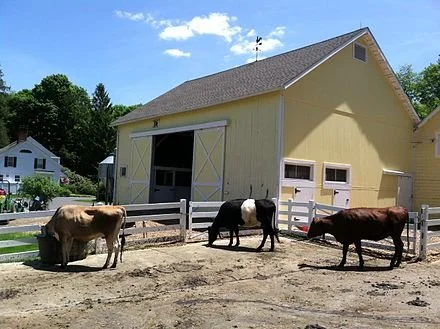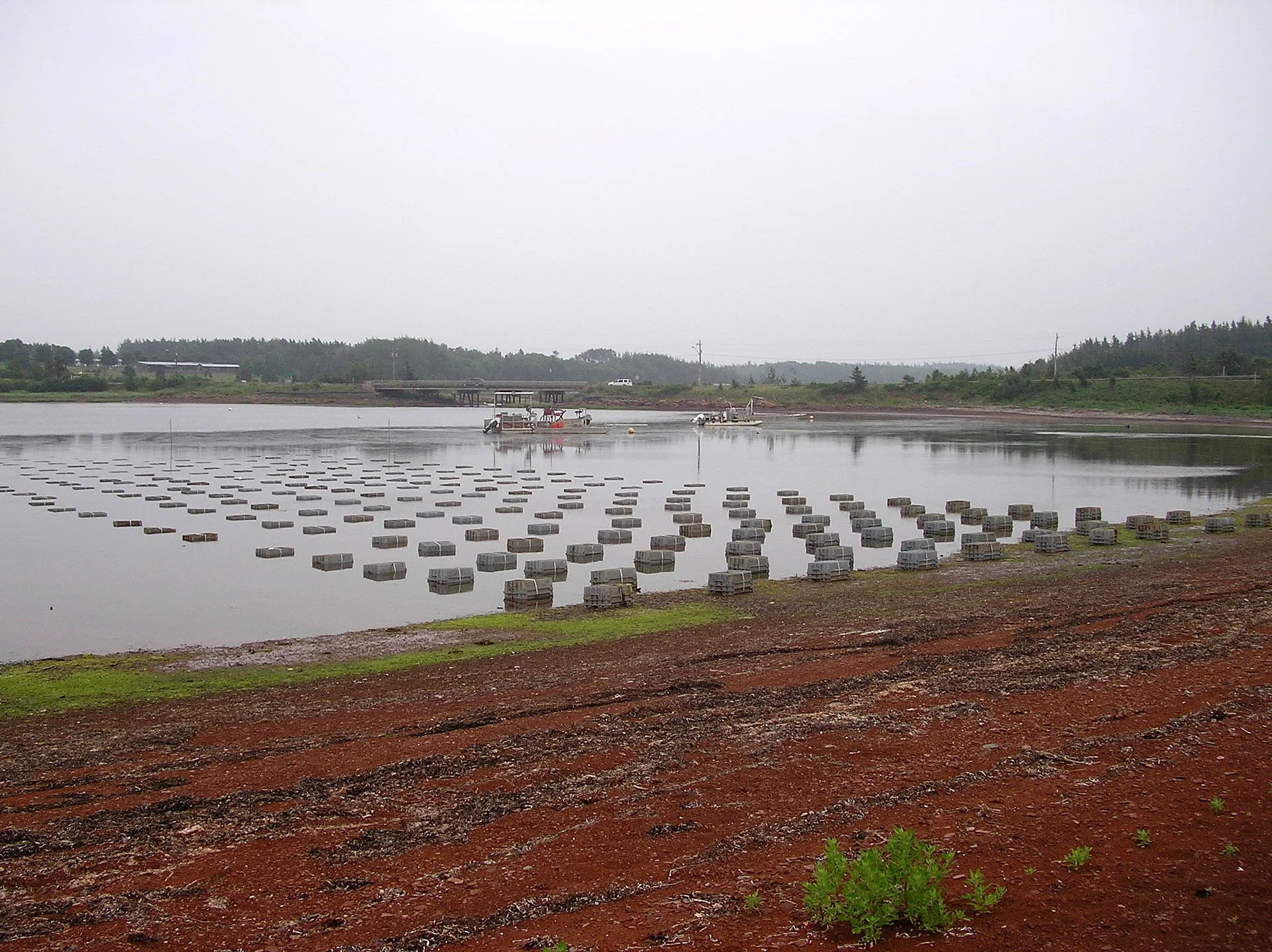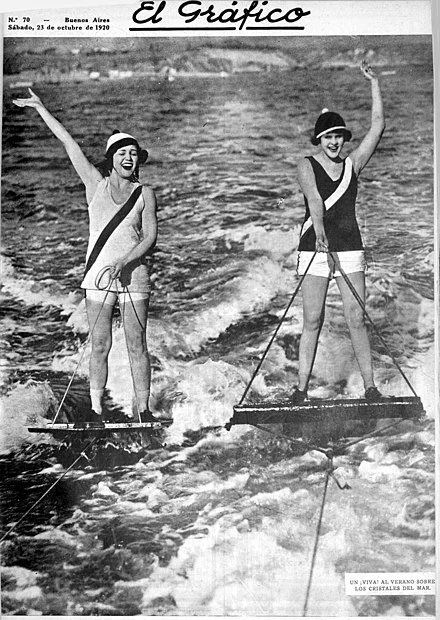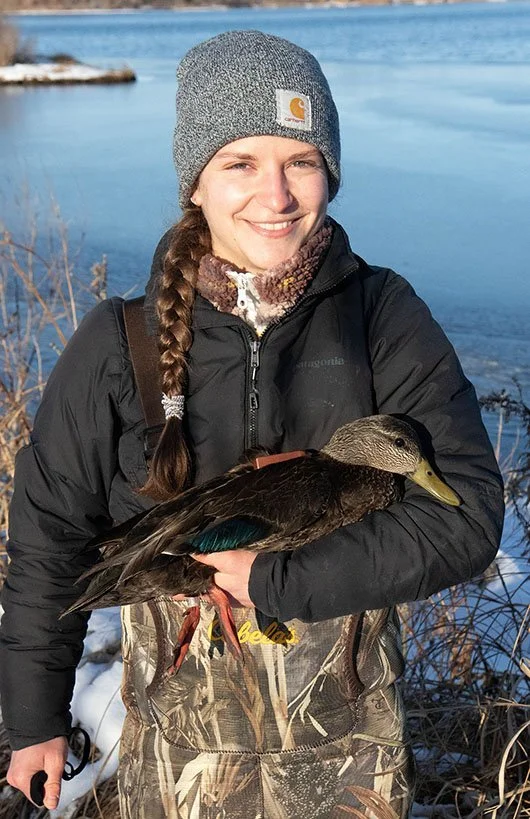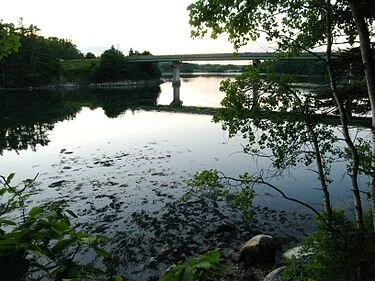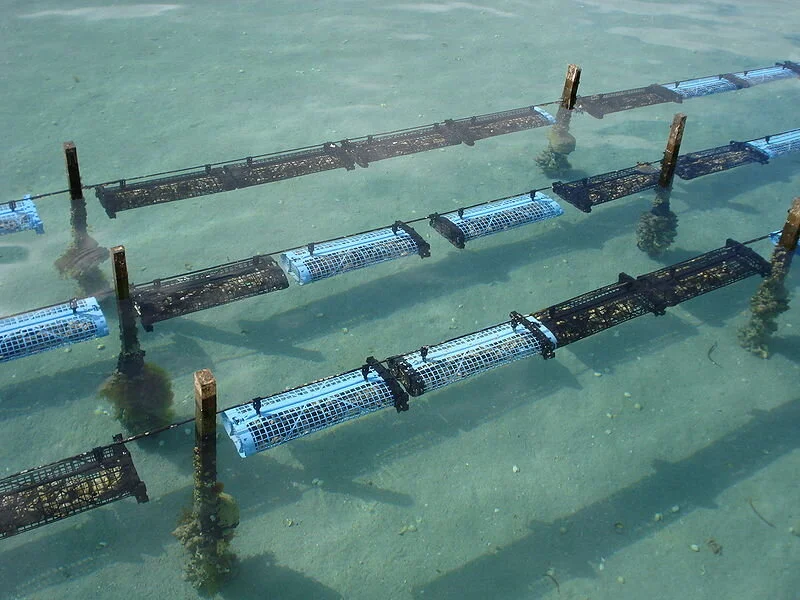
n
UMaine setting up new aquaculture research and training center
Planned University of Maine aquaculture training and research center.
— Image courtesy of its architects, Andover, Mass.-based SMRT Architects and Engineers
Images from the book Maine Oysters: Stories of Resilience and Innovation
Edited from a New England Council report:
The University of Maine is working on a 14,200-square-foot addition to its Sustainable Workforce Innovation Center to serve the Pine Tree State’s growing aquaculture center.
Scheduled to open in 2025, at the university’s flagship campus, in Orono, the $10.3 million research and training center will prepare workers for aquaculture careers, and help the state address the challenges of its finfish, oyster and mussel farms.
“[The center] links research with teaching, so there’s classroom and research space together, and it brings in professionals from the aquaculture industry, academic researchers and experts and students to work together on identifying and addressing the kinds of issues that the aquaculture industry confronts,” said Trish Riley, chair of the University of Maine System Board of Trustees.
New England may have to grow more of its own food
At a dairy farm in Redding, Conn., an exurban town. The state’s two biggest agriculture sectors are horticulture and dairy.
Vermont’s coat of arms reminds us of how important farming, especially dairy, has been to the Green Mountain State. But in the first half of the 19th Century, raising Merino sheep for wool was the big thing.
Produce from Mack’s Apples, a farm in Londonderry, N.H., that goes back to 1732.
Adapted from Robert Whitcomb’s “Digital Diary,’’ in GoLocal24.com
The New England State Food System Planners Partnership has looked into how the region could boost its food production so that it could produce 30 percent of the food it consumes by 2030. We’ve been harvesting less than about 20 percent of the food we eat.
Wouldn’t it be nice if the six states could grow enough vegetables and grains, and catch and grow enough animal protein (especially finfish and shellfish), so that it wouldn’t have to import nearly as much from far away, much of it from huge agribusinesses, with the accompanying energy and other costs. In so doing we’d get fresher food, employ many more New Englanders, reduce fossil-fuel burning and in some places get cheaper stuff to eat.
Something else to consider: Global warming and all its associated issues are expected to hit hard in such huge agribusiness regions as the Midwest, Florida and California’s Central Valley. New England’s climate outlook is much less forbidding. In any event, we may have to grow more of our food.
Of course, we think about this more in the summer, when we enjoy locally grown super-fresh vegetables. But an increasing number of large indoor “farms’’ are slowly adding to our locally grown year-round vegetable crops. And the warming climate might substantially extend our growing season.
Most of New England’s farmland is in the three northern states, which are largely rural. That won’t change, but we ought to encourage more agriculture near cities in Massachusetts, Rhode Island and Connecticut. That would reduce shipping costs. Many farms in Europe and elsewhere abroad are remarkably close to large and small cities.
Where to find the land? One is to use some of the open space (parking lots, etc.) freed up by the demise of many shopping centers in the Age of Amazon. Of course, much of this acreage would require extensive remediation to make it safe for agriculture. Then there’s cutting down trees in some places to convert to farmland. There used to be much, much more open land devoted to farming (especially for dairy cows) in New England before the opening up of the flat and fertile farmland in the Middle West, California’s Central Valley and elsewhere. That made many of our region’s farms, most of which were small because of the hilly and rocky terrain in much of our region, economically uncompetitive. (There were some big exceptions, most notably the Connecticut River Valley.) Thus New England is far more wooded than it was 150 years ago.
But we’d need studies on how reducing our woodlands to plant food might worsen global warming. Trees absorb huge amounts of carbon dioxide.
There’s been a bit of revival in raising cattle and pigs in some parts of New England for high-end markets. But raising such animals for slaughter is, in food-production and nutrition terms, very wasteful compared to raising plants. Most Americans still love eating red meat, though many who know the health drawbacks and/or have seen the horrific slaughtering process have given it up.
Then there’s aquaculture, a source of high-quality protein that could be greatly expanded. It was mild good news that Perry Raso, the South Kingstown, R.I. restaurateur and shellfish farmer, has reportedly received approval to modestly expand his farming.
The National Oceanic and Atmospheric Administration is getting $3.3 billion under the Biden Administration’s Inflation Reduction Act to invest in science-based management and conservation of marine resources amidst global warming. Let’s hope that some of this money promotes coastal aquaculture.
Bravo to the New England State Food System Planners Partnership as it presses for greater regional food independence – good for public health, our economy and the environment.
Enjoy the sweet corn, tomatoes and other treasures of the New England summer. Patronize those farmstands.
Out-of-staters vs. R.I. aquaculture
Oysters farmed in baskets on Prince Edward Island.
— Photo by Santryl
Adapted from Robert Whitcomb’s “Digital Diary,’’ in GoLocal24.com
New Rhode Island state rules mandate that people who want to expand or start new aquaculture farms (mostly shellfish) must identify property owners within 1,000 feet of their projects’ boundaries. The Coastal Resources Management Council will then notify those abutters about the proposal so that they have plenty of time to fight it.
Many, and in some places most, of the abutters will be wealthy out-of-state summer people who like to eat oysters, and can afford to buy lots of them, but many don’t want aquaculture near them, though it’s good for the area’s economy. They’ll get high-fee lawyers to try to block the farms.
Aquaculture and waterfowl
URI graduate student Tori Mezebish holds a black duck she tagged as part of her research on the interactions between waterfowl and aquaculture facilities. (Courtesy photo)
From ecoRI News (ecori.org)
As aquaculture operations expand in Narragansett Bay and Rhode Island’s salt ponds, questions have arisen about how ducks and geese are impacted by the facilities. To begin to answer these questions, a University of Rhode Island doctoral student is tracking the movements of local waterfowl.
“There haven’t been any Rhode Island studies yet, but studies on the Pacific Coast have found issues with diving ducks getting tangled up in netting used by aquaculture, and birds that have been deterred from areas that might otherwise be good habitat because of the activities of aquaculture operations,” said Tori Mezebish, a native of Maryland who is collaborating on the project with URI professors Peter Paton and Scott McWilliams and officials from the Rhode Island Department of Environmental Management.
She noted previous studies have also observed sea ducks such as eiders and scoters, which feed on mollusks, preying on oysters and other shellfish being grown by aquaculturists.
“There’s also been some positive associations, like ducks and geese eating some of the aquatic vegetation that accumulates on the cages,” Mezebish said. “It’s a mixed bag of how the birds might interact with aquaculture.”
Last winter, Mezebish attached transmitters to 30 black ducks and 30 brant, a species of goose that lives in salt water. This winter she will deploy an additional 30 transmitters on common goldeneyes, a diving duck. All three species are common during winter in Narragansett Bay, the state’s salt ponds, and adjacent salt marshes.
Most of the brant have returned from their breeding grounds in the Arctic, and several of them spend every day with dozens of other brant on the lawn at Colt State Park in Bristol. Others are spending most of their time in the upper bay and Providence River. The black ducks are just beginning to return to the area from Maine and southern Canada, and the early arrivals have been tracked to the salt ponds and the Galilee area.
Mezebish is tracking the movements of each bird using a GPS unit on their transmitters to see how much time they spend near aquaculture facilities. She is also observing the birds in the field to validate the GPS data and see what the birds are doing around the shellfish farms.
“The goal is to understand what is important to these species outside of the aquaculture facilities,” she said. “Maybe brant need shallow areas with submerged vegetation, so that may not be the best place to put an aquaculture lease.”
In addition to Mezebish’s study, URI postdoctoral researcher Martina Müller is conducting land-based surveys throughout the year to see what other kinds of birds may be interacting with aquaculture facilities.
“Ultimately, we want to provide recommendations about the good and not so good places for aquaculture leases to be placed,” said Mezebish, who became interested in waterfowl research as an intern at the Pawtuxet Wildlife Research Center in Maryland, where she hand-reared ducklings used in the center’s research activities.
When the project is complete, Mezebish hopes to use the study as a springboard to study related questions about other conflicts and interactions between waterfowl and humans.
Maine gets grant for aquaculture research
The Damariscotta River is the center of Maine’s burgeoning oyster farming sector.
Baskets used to grow juvenile oysters
— Photo by Saoyster
From The New England Council (newenglandcouncil.com)
The University of Maine (UMaine) has been selected to receive a $123,735 grant from the National Oceanic and Atmosphere Administration (NOAA). The grant will be given to UMaine’s Aquaculture Research Institute, which was established in 2009 and has completed more than 50 aquaculture projects in the past five years.
The grant is a part of NOAA’s Sea Grant National Aquaculture Initiative to donate over $16 million to 42 projects nationwide. NOAA’s grant will fund UMaine’s pilot program, “Aquaculture Workforce Development: Certificate in Applied Sustainable Aquaculture,” which was designed to address the aquaculture industry workforce needs by introducing and developing alternate career opportunities for traditional fishing communities. In addition, the project incorporates UMaine’s internship program to create an industry and academic partnership pipeline.
“Maine’s history of innovation, collaboration and economic development in this sector positioned institutions in the state to compete successfully for almost one-third of the federal funds awarded,” says Gayle Zydlewski, director of Maine Sea Grant and a professor in the UMaine School of Marine Sciences.
Diversified fishing; Shifting away from the Sunbelt
Cultured sea scallop.
From Robert Whitcomb’s “Digital Diary,’’ in GoLocal24.com
A wonderful story and video by Maine Public Radio’s Fred Bever describes how Maine fishermen are diversifying to address the challenges posed by overfishing and global warming.
Mr. Bever writes:
“These days it’s mostly lobster, but he {fisherman Marsden Brewer} has fished cod and shrimp, and carted urchin to market. They were all once-vibrant species, but now they’re mostly off-limits after being overfished and weakened by climate change.’’ And Mr. Brewer has moved in a big way into scallop aquaculture.
Jon Gorman, who works at Bangs Islands Mussels, told Mr. Bever:
“I see a lot of growth and you never know. We’re going to be doing scallops, then we’ll be back to mussels, and then the springtime and fall we’re into kelp. It’s fun.”
There are some good ideas in the story for southern New England fishermen.
To see and hear Mr. Bever’s report, please hit this link.
As global warming intensifies, and extreme storms, drought and floods ravage some areas, some predict a reverse migration of people from the southern and western U.S. to such places as the Upper Midwest and inland (!) New England, whose climates are expected to remain relatively moderate and that will continue to have lots of fresh water, which is actually better to have than oil, coal and natural gas!
The big population move to the Sunbelt, with all its socio-economic and political effects, may reverse in the next couple of decades – or before.
By the way, water temperatures in the Gulf of Mexico are four degrees warmer than “normal’’. They’ve often been warmer than “normal’’ for some years now, and at the moment are about 85 degrees. This means more fuel for hurricanes – e.g., Hurricane Michael. Keep burning those fossil fuels and maybe we can get the Gulf up to 95 degrees in the summer in a couple of decades. There won’t be much sea life left, but it will be perfect for a soothing swim. To read more, please hit this link.
Our weather narcissism
By ROBERT WHITCOMB
Inevitably, some politicians and entertainers (e.g., Rush Limbaugh) are having great fun with the cold and snowy winter in the East and Midwest, saying that this shows that “global warming” is a fraud.
But they are extrapolating from immediate experience and anecdote, not science. I suspect that most of these people know better, but, hey, they’re in show biz.
Actually, January, for instance, which the news media lamented for its cold, snow and ice, has been rather severe in the eastern U.S. because of a huge dip in the jet stream that has brought cold (though not unprecedented cold) to the Upper Midwest and the Northeast while out West, including Alaska, it’s generally been very warm and dry for this time of year. Northeasterners and Midwesterners have endured temperatures 10, 15 or more degrees below normal; Alaska and California have been 10-15 degrees above. And the National Oceanic and Atmospheric Administration reports that January was, on a global basis, the fourth-warmest on record.
That the Northeast is so densely populated and that much of the national news media are based in New York and Washington mean that the idea that this winter is particularly bad has particularly strong currency. It recalls E.B. White’s funny 1954 essay “In the Eye of Edna,” in which he noted that the nation lost interest in Hurricane Edna after it moved beyond Boston’s radio and TV stations to wallop White’s comparatively remote Mid-Coast region of Maine.
Then there are such relatively new weather-news outlets as the Weather Channel and Accuweather. These commercial outlets will die if they fail to constantly dramatize such old weather phenomena as “The Polar Vortex” — a low-pressure area in upper latitudes that now is presented almost as a new and lethal threat to civilization. Weather events that would have seemed par for the course of a season a half century ago are now characterized as world-historical events.
Changes in the route of the jet stream from time to time bring cold air deep into the eastern part of the United States while the other side of the country becomes much warmer than usual as the jet stream brings in mild, Pacific air from the southwest. The jet stream’s position, of course, can vary widely but it can sometimes get stuck, meaning warm, “open” winters for us some years and cold ones in others. The general trend, though, is for milder winters. The trouble is that we confuse events in our areas that are part of weather’s natural variability with global climate change.
The confusion of one’s particular circumstances with the wider reality reminds me of the heartening rise in recent years of “evidence-based medicine” as opposed to the more traditional “expert-based medicine.” I am simplifying, but evidence-based medicine relies much less on individual physicians’ experience, values and judgment and much more on cold, hard data derived from rigorous collection and analysis of information from broad populations. As with medicine, so with climate, follow the data.
Anyway, New Englanders have suffered through another week of below-normal weather and are heartily sick of it. That the population is aging and that old people, in particular, find winters wearisome may reinforce the winter fatigue of younger people, too.
In some winters, snow drops and crocuses would be popping out of south-facing slopes about now. It looks as if we’ll have to wait a while for them this year. Still, a gradual change in the mix of morning bird song and that there’s bare ground around the base of trees where there was snow a week or two ago reminds us that the sun is getting stronger by the day: Some birds are coming north again and there’s more solar energy for the trees to absorb. And on one of our recent, and for this winter, rare mild days, I found the worms wiggling enthusiastically in our compost bin, whose contents seem to have been frozen solid a couple of days before. Worms: A reminder of the cycles of death and life.
***
The Feb. 23 New York Times business section story “Loss Leader on the Half Shell: A national binge on oysters is transforming an industry (and restaurants’ economics)” was heartening for a coastal New Englander. It implied that our estuary-rich region could benefit a lot from much expanded shellfish aquaculture. Unlike, say, casinos, which are a net subtraction from a region’s economy, or local businesses that recycle money that’s already here, aquaculture, because it has exportable physical products and brings people here from far away to buy them in our eateries as local specialties, increases our region’s wealth.
And the business, with its demands for clean water, prods us to keep our coastal environment cleaner.
Robert Whitcomb (rwhitcomb51@gmail.com), a former Providence Journal editorial-page editor, is a Providence-based writer and editor and the overseer of www.newenglanddiary.com. He is also a director of Cambridge Management Group (cmg625.com).




